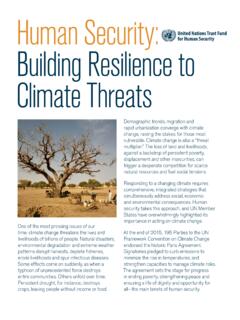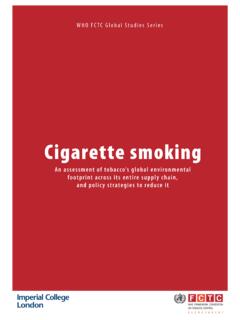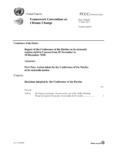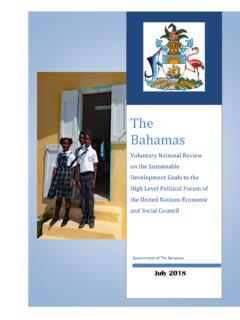Transcription of HUMAN SECURITY HANDBOOK - United Nations
1 1H U M A N SECURITY HANDBOOKAn integrated approach for the realization of the Sustainable Development Goals and the priority areas of the international community and the United Nations systemHuman SECURITY Unit United Nations January 20162 CONTENTSA cronyms ..3 Introduction ..4 The HUMAN SECURITY Approach and Its Added Value ..5 Towards a Stronger Response by the United Nations System ..11 Application of the HUMAN SECURITY Approach to Programmes and National Plans ..17 Annex 1 - Designing a HUMAN SECURITY Programme: A Case Study from Kenya ..30 Annex 2 - Examples of Programmes Funded by the United Nations Trust Fund for HUMAN SECURITY ..403 ACRONYMSFAO Food and Agriculture Organization ILO International Labour Organization MDGs Millennium Development Goals NGO Non-governmental organization SDGs Sustainable Development Goals UNESCO United Nations Economic, Scientific and Cultural Organization UNDP United Nations Development Programme UNFPA United Nations Population Fund UN Habitat United Nations HUMAN Settlements Programme UNHCR United Nations High Commissioner for Refugees UNICEF United Nations Children s Fund UNIDO United Industrial Development Organization UNTFHS United Nations Trust Fund for HUMAN SECURITY UNV United Nations Volunteers UN Women United Nations Entity for Gender Equality and the Empowerment of Women WHO World Health Organization4 INTRODUCTIONP repared as a guide for practitioners and policymakers who plan to integrate the HUMAN SECURITY approach into their work, this HANDBOOK provides an overview of the principles that embody the approach and its added value.
2 It introduces a step-by-step analytical process for the design and im-plementation of HUMAN SECURITY initiatives, and provides guidance for assessing the added value of the approach. A detailed case study from the Turkana region of Kenya demonstrates the application of HUMAN SECURITY tools to analyse a complex situation and develop an integrated multisectoral approach. This is followed with additional examples of programmes supported under the United Nations Trust Fund for HUMAN SECURITY (UNTFHS).This HANDBOOK assumes prior knowledge in programme/project management methods, such as results-based management as well as logical framework analysis, and will be accompanied by a series of trainings for United Nations entities, field staff and other HUMAN SECURITY APPROACH AND ITS ADDED VALUE For many people, today s world is an insecure place, full of threats on many fronts. Natural disasters, violent conflicts, chronic and persistent poverty, health pandemics, international terrorism, and sudden economic and financial downturns impose significant hardships and undercut prospects for sustainable development, peace and stability.
3 Such crises are complex, entailing multiple forms of HUMAN insecurity. When insecurities overlap, they can grow exponentially, spilling into all aspects of people s lives, destroying entire communities and crossing national of today s development or humanitarian challenges arise from multiple factors that are in-terconnected and mutually reinforcing. These require greater integration of activities across the United Nations system and in partnership with others. For people in crisis and extreme poverty, acting on single issues is not enough. Insecurities must be tackled together, comprehensively. Only then will people begin to feel safe in all aspects of their lives, have the income and opportunities to attain well-being, and know that their rights and dignity are fully respected. Only then will they enjoy HUMAN SECURITY a more powerful, lasting approach to the most difficult deficits in peace and HUMAN SECURITY approach can reinforce United Nations support to Member States in strength-ening resilience to climate change and natural disasters; promoting peaceful and inclusive societies; addressing the underlying causes of persistent poverty; and bolstering the transition from humani-tarian crisis to longer term sustainable development.
4 As such, the application of the HUMAN SECURITY approach can significantly enhance actions taken by the United Nations and its partners to fully realize the transformative promise of Agenda 2030 and the Sustainable Development Goals (SDGs). Agenda 2030 underscores that an integrated sustainable development agenda requires an equally synergistic framework for its implementation, and that a truly sustainable development agenda must be inclusive and people-centred. Echoing the HUMAN SECURITY approach, Agenda 2030 calls for development strategies that result in more resilient societies where people are safe from chronic threats such as abject poverty, hunger, disease, violence and repression, and protected from sud-den disruptions in their daily lives. In short, the HUMAN SECURITY approach is a crucial ingredient to achieve sustainable development. - A COMMON UNDERSTANDING OF HUMAN SECURITYThe HUMAN SECURITY approach provides a new way of thinking about the range of challenges the world faces in the 21st century and how the global community responds to them.
5 It is a multidi-mensional analytical framework that can assist the United Nations system to assess, develop and implement integrated responses to a broad range of issues that are complex and require the com-bined inputs of the United Nations system, in partnership with Governments, non-governmental entities and communities . The adoption of General Assembly resolution 66/290 on 10 September 2012 was a significant mile-stone for the application of HUMAN SECURITY . In paragraph 3 of the resolution, the General Assembly agreed by consensus that HUMAN SECURITY is an approach to assist Member States in identifying and addressing widespread and cross-cutting challenges to the survival, livelihood and dignity of their people. Based on this, the General Assembly endorsed the following common understanding to guide the application of the HUMAN SECURITY approach within the United Nations system:a. The right of people to live in freedom and dignity, free from poverty and despair.
6 All individu-als, in particular vulnerable people, are entitled to freedom from fear and freedom from want, with an equal opportunity to enjoy all their rights and fully develop their HUMAN potential;b. HUMAN SECURITY calls for people-centred, comprehensive, context-specific and prevention-ori-ented responses that strengthen the protection and empowerment of all people and all com-munities;c. HUMAN SECURITY recognizes the interlinkages between peace, development and HUMAN rights, and equally considers civil, political, economic, social and cultural rights;d. The notion of HUMAN SECURITY is distinct from the responsibility to protect and its implemen-tation; e. HUMAN SECURITY does not entail the threat or the use of force or coercive measures. HUMAN SECURITY does not replace State SECURITY ;f. HUMAN SECURITY is based on national ownership. Since the political, economic, social and cultural conditions for HUMAN SECURITY vary significantly across and within countries, and at different points in time, HUMAN SECURITY strengthens national solutions which are compatible with local realities;Governments retain the primary role and responsibility for ensuring the survival, livelihood and dignity of their citizens.
7 The role of the international community is to complement and provide the necessary support to Governments, upon their request, so as to strengthen their capacity to respond to current and emerging threats. HUMAN SECURITY requires greater collaboration and partnership among Governments, international and regional organizations and civil society; HUMAN SECURITY must be implemented with full respect for the purposes and principles enshrined in the Charter of the United Nations , including full respect for the sovereignty of States, territorial 7integrity and non-interference in matters that are essentially within the domestic jurisdiction of States. HUMAN SECURITY does not entail additional legal obligations on the part of - APPLYING THE HUMAN SECURITY APPROACHThe HUMAN SECURITY approach is a comprehensive methodology that allows for a broad perspective on the challenges that people and Governments face. It reminds us that the challenges that the international community must address are not simple, nor can they successfully be ameliorated through separate initiatives, each assigned to a particular organization.
8 The HUMAN SECURITY approach, however, is more than an exercise in joint programming. It has five fundamental principles that differentiate it from simply working together. These are: People-centred Comprehensive Context-specific Prevention-oriented Protection and empowermentFirst and foremost, the HUMAN SECURITY approach is people-centred. It considers the broad range of conditions that threaten the survival, livelihood and dignity of people and their communities , particularly those who are most vulnerable. Second, the HUMAN SECURITY approach recognizes the complexity and interconnected nature of the 1 Based on the 1994 UNDP HUMAN Development Report, New Dimensions of HUMAN of HUMAN insecurities and possible root causes1 TYPE OF INSECURITYROOT CAUSESE conomic insecurityPersistent poverty, unemployment, lack of access to credit and other economic opportunitiesFood insecurityHunger, famine, sudden rise in food pricesHealth insecurityEpidemics, malnutrition, poor sanitation, lack of access to basic health careEnvironmental insecurityEnvironmental degradation, resource depletion, natural disastersPersonal insecurityPhysical violence in all its forms, HUMAN trafficking, child labourCommunity insecurityInter-ethnic, religious and other identity-based tensions, crime, terrorismPolitical insecurityPolitical repression, HUMAN rights violations, lack of rule of law and justice8challenges that confront people and their aspirations to be free from want.
9 Fear and indignity. By being comprehensive and by drawing together all the actors necessary to respond to a challenge, the application of HUMAN SECURITY ensures coherence, eliminates duplication and advances inte-grated solutions that result in more effective and tangible improvements in the day-to-day life of people and their is no one size fits all in addressing today s challenges . Recognizing that risks to the HUMAN condition vary considerably within and across countries, and at different points in time, the HUMAN SECURITY approach recognizes context-specific variances, including the differing capacities of people, civil society and Governments, as well as the root causes behind ongoing and future HUMAN SECURITY approach goes beyond quick responses and is prevention-oriented. By drilling down to ascertain the real causes of challenges and by building solutions that are in themselves sustainable and resilient, HUMAN SECURITY promotes the development of early warning mechanisms that help to mitigate the impact of current threats and, where possible, prevent the occurrence of future , the HUMAN SECURITY approach recognizes that there are inherent responsibilities within each and every society.
10 Empowering people and their communities to articulate and respond to their needs and those of others is crucial. Likewise, top-down norms, processes and institutions, including the establishment of early warning mechanisms, good governance, rule of law and social protection instruments are fundamental characteristics of the HUMAN SECURITY approach. It brings measures into a framework that can better address complex challenges to the HUMAN condition. The five principles making up the HUMAN SECURITY approach are mutually reinforcing and cannot be implemented as separate objectives. HUMAN SECURITY involves recognizing the strengths that accrue from true partnerships where different entities combine their strengths to create synergies that can achieve far greater impact in addressing today s complex and multidimensional challenges . - HUMAN SECURITY S ADDED VALUE AS AN OPERATIONAL TOOLThe strength and appeal of HUMAN SECURITY as an operational tool for analysis, implementation and impact lies in the following components:i.














